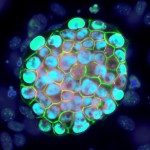Link to Pubmed [PMID] – 2539508
J. Virol. 1989 May;63(5):2134-42
An ecotropic murine leukemia virus (MuLV) isolate has recently been shown to be able to infect the germ line or the early embryo or both when inoculated at birth to SWR/J females (J. J. Panthier, H. Condamine, and F. Jacob, Proc. Natl. Acad. Sci. USA 85:1156-1160, 1988). We have used this isolate to further study this phenomenon. By using the techniques of RNA-RNA in situ hybridization, immunocytochemistry, and transmission electron microscopy, the identities of two important cell types that are infected by ecotropic MuLV in the gonads of inoculated mice were determined. These cells are the thecal cells surrounding the follicles in the ovary and the Leydig cells in the testis. Both types actively synthesize viral RNA and express a viral antigen. Furthermore, we documented the production of viral particles by the thecal cells. The expression of ecotropic MuLV by nonlymphoid cells in vivo may play a key role in the vertical transmission of these viruses by females as well as in their horizontal transmission.

